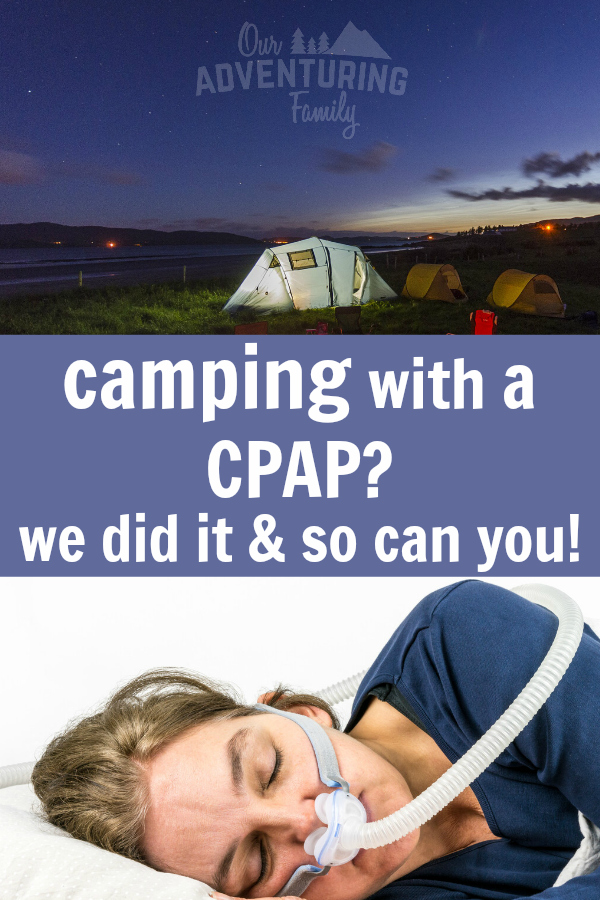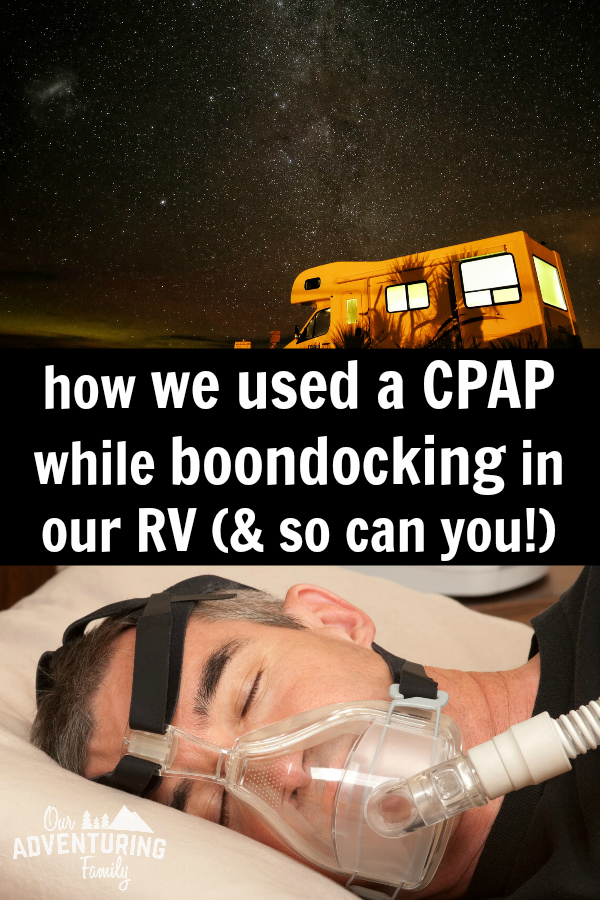This post may contain affiliate links. As an Amazon Associate I earn from qualifying purchases, but there is no additional cost for you. Please see my Disclosure page for more information.
A few months ago I wrote about using a CPAP while boondocking in an RV. We were primarily looking for ways to power a CPAP without draining our RV battery. But it was all theory, as I explored the options available to us. As I stated in that post, we hadn’t actually had a chance to try it out for ourselves.
Jeremy’s had his CPAP for several months now (it’s a ResMed AirSense 10) and it’s made such a difference in his sleep. It’s not something he’s willing to sleep without, so we brought it with us on our recent road trip. We did some boondocking on that trip, so we had the chance to put the ideas from my first CPAP post to the test.
Spoiler: it’s definitely possible to use a CPAP while boondocking! He’s also used his CPAP while tent camping, so if that’s more your style, these tips will still be useful.
First, we ordered the 100 watt Paxcess power bank from Amazon. We also ordered this car charger/dc adapter cord that the CPAP plugs into before plugging into the power bank. That cord is the one that works for Jeremy’s CPAP, you may need a different one. We rounded off our preparations with a Paxcess foldable 50 watt solar panel. We spent about $310 for all three items.
Next we set out to test how long the power bank would last at night and how long it would take to charge during the day. We did this before our trip, during our trip, and have continued to try different things since returning home, still looking for the optimal combination of power bank longevity and effective CPAP usage.
Our experience using a CPAP while boondocking
We opted for the budget-friendly 100 watt Paxcess power bank, and it looked fully charged when it arrived. However, the kids played with it so it wasn’t fully charged when Jeremy used it the first time. It only lasted 4.5 hours the first night. We charged it all day the next day, and that night it lasted all night, with two bars left. However, that was also with the humidifier and heater settings adjusted to reduce the power drain. Jeremy found that to be too drying and not something he was willing to do again, even if it it did make the power bank last longer. In the end, he only got about 4 hours of use before the power bank died each night.
We had hoped that as we drained and charged the power bank several times that its longevity would improve, but that never proved to be the case. We ended up ordering a replacement power bank from Amazon while we were on our trip and had it delivered to Jeremy’s grandma’s house. The replacement has performed a little better (it lasts about 6 hours a night), but we would prefer something that lasts at least 8 hours at a stretch.

Charging our power bank
We knew we wouldn’t always have access to a plug in the wall, so we experimented to see how long the power bank took to charge using different methods.
1. Charged while plugged into wall
It took about 5 or 6 hours to fully charge. We charged the power bank at home and while in the RV, when we were plugged into the power at Jeremy’s grandma’s house. Both worked equally well.
2. Charged while driving down the road
It took about 5 or 6 hours to charge using one of our inverters. Since we were driving long hours at a time, we were able to fully charge the power bank without any problems on our driving days.
3. Charged with solar panels

The solar panels fold up small inside a canvas case for easy transport and protection. We used the corner grommets to position the panels to catch the sun. There are also several USB connectors that we used to charge our cell phones. It’s not the fastest process, but it does work, especially if you have a lot of sunshine to work with. This would be a great option if you’re tent camping without access to a vehicle or building with electricity. We may get this 100 watt foldable solar panel to see if it can charge our electronics more quickly.
How to make your power bank last longer
1. Use a dc adapter
That car charger/dc adapter cord I mentioned earlier might not seem important, but it is recommended to make the power bank last longer than if you plug your CPAP directly into the power bank.
2. Turn off tube heating and/or the humidifier
Adjusting these settings as low as possible or turning them off completely will reduce the power drain. Jeremy tried this the night the power bank lasted the longest, but he found it to be too drying on his airways.
While he’s not able to make use of this suggestion on a nightly basis, it did have a significant impact on how long the power bank lasted. This is definitely something to test out before you hit the road or go camping so you know what your comfort levels are and how you can balance them with your available power.
Our recommendations
We stand by our advice to thoroughly test things out before your trip. But make sure you also have enough time to return and replace the power bank if you run into any problems. We had time to replace our power bank before we left, but we second-guessed ourselves, thinking its performance would improve. By the time we realized it wouldn’t, it was too late to receive a replacement. These power banks can only be delivered via ground shipment because of the lithium batteries in them, so there’s no quick 1 or 2 day Prime delivery available.
In the end, we can’t recommend the Paxcess 100 watt power bank. Though the listing claims it will power a CPAP, that just hasn’t been our experience. Maybe if your CPAP draws less power, it will work for you.
In comparing similar power banks, the consensus seems to be that the power bank needs to have a higher wattage to power a CPAP through the night or for multiple nights. We’ll soon be trying out the 280 watt Paxcess power bank, which is on sale and may also have a $20 coupon, depending on when you’re reading this, which brings the price down quite close to what we originally paid for the 100 watt power bank. I’ll report back in a few months on our experiences with that power bank.
We’ll keep the 100 watt power bank and use it for charging other electronics and as a backup power source in case of power outages, so it’s not a complete waste of money. It’s been a good learning experience for us and it’s so good to know that we can still go camping without hookups without sacrificing Jeremy’s health.
Have you used a power bank to run your CPAP while boondocking? Do you recommend that brand? I’d love to hear your experiences!








Did you try the 280 Watt??
Yes, we have! And it worked so much better than the 100 watt one- it lasted all night plus some! We did discover some variances that could be affecting how long the power bank lasts each night (temperature, type of mask, etc), so we’re doing some more testing before I write a follow-up 🙂